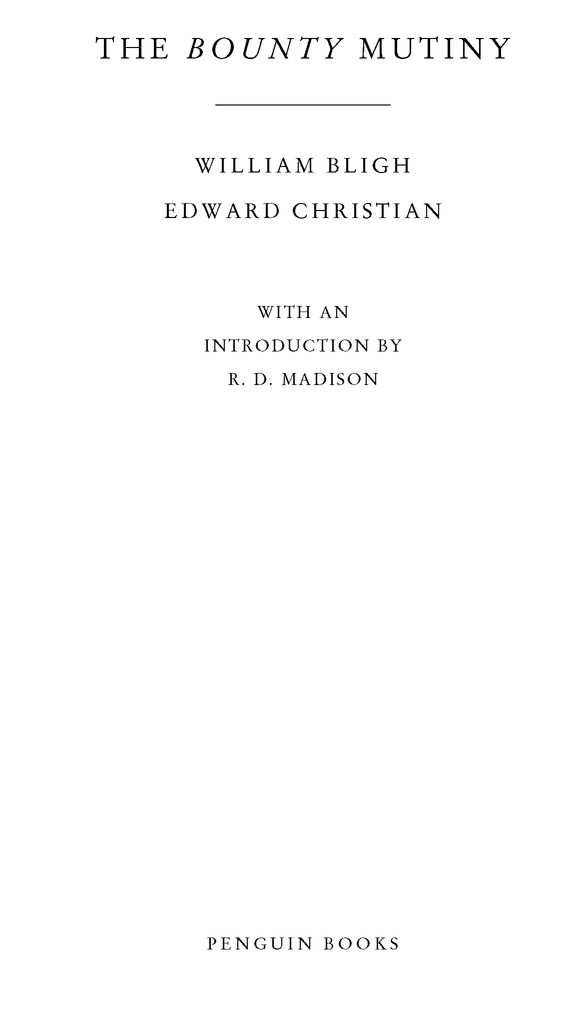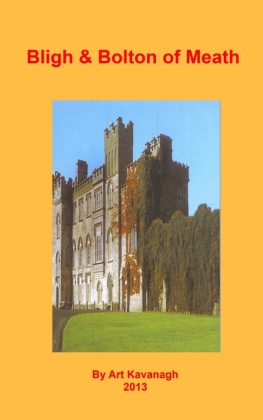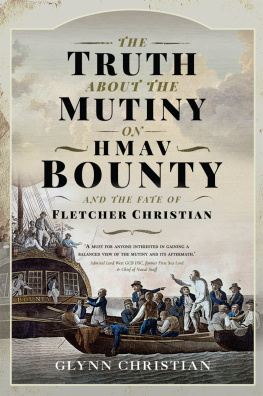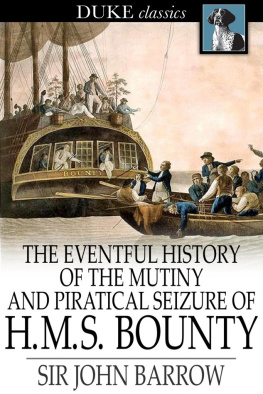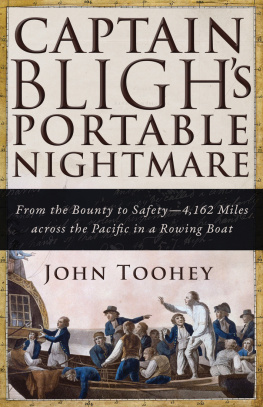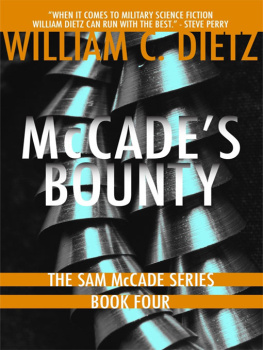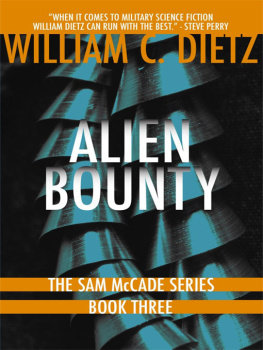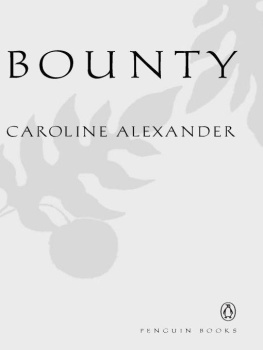Table of Contents
PENGUIN

CLASSICS
THE BOUNTY MUTINY
William Bligh was born near Plymouth, England, in 1754. In 1762, at the age of seven, he was entered on the books of the Monmouth as captains servant, although he may not have actually served. In 1776, at age twenty-two, he was appointed master of the Resolution, under the command of the celebrated James Cook. Shortly after Cooks death and the return of his expedition in 1780, Bligh married Elizabeth Betham. In 1787, after several voyages in naval and merchant vessels, Bligh was offered command of an expedition to transplant breadfruit plants from Tahiti to the West Indies in the Bounty. In 1791 he undertook a more successful breadfruit voyage in the Providence. After being incidentally involved in the mutiny at the Nore, Bligh commanded the Director at the Battle of Camperdown in 1797 and the Glatton at the Battle of Copenhagen in 1801. In 1805 Bligh was offered the governorship of New South Wales. He died in 1817 in London and was buried in Lambeth.
Edward Christian, brother of mutineer Fletcher Christian, was born in 1758 near Cockermouth in the Lake District. Counsel for William and Dorothy Wordsworth in their famous suit against James Lowther, he became chief justice of the Isle of Ely and professor of law at Cambridge. He died in 1823.
R. D. Madison teaches English at the U.S. Naval Academy in Annapolis, Maryland. He has edited several volumes of military and naval history, including Robert Southeys Life of Nelson, David Porters Journal of a Cruise, and Thomas Wentworth Higginsons Army Life in a Black Regiment and Other Writings (Penguin Classics, 1997).
For Jay Bercaw
INTRODUCTION
The names of William Bligh, Fletcher Christian, and the Bounty have belonged to the popular culture of the English-speaking world for over two hundred years. The story of the most famous mutiny has many beginnings and many endingsall of which intersected on an April morning in 1789 near the Pacific island group we now call Tonga. On that morning, William Bligh and a handful of barely loyal supporters, put off the Bounty into a small launch, began the greatest boat voyage in history, while Fletcher Christian and the Bounty sailed off into a mystery which has never been entirely resolved, despite the discovery of the Bounty colony on Pitcairn Island some twenty years later.
I
Perhaps the story is best begun with a look at the life of the commanding officer. William Bligh was born in or near Plymouth, England, on 9 September 1754. Destined for the navy, he was entered on the books of the Monmouth as captains servant in 1762, at the age of seven, although he may not actually have served. Such an entry was useful to give young aspirants for a naval career a head startat least on paper if not in actual service. Perhaps such a custom was the more welcome if the captain in question merely pocketed any wages due to the mythical apprentices. By 1770, however, Bligh was regularly entered in the Hunter as an able-bodied seamana suitable designation for a youngster waiting for a commission. He must have been extraordinarily talented at seamanship and navigation, for at age twenty-two he was appointed sailing-master of the Resolution under the celebrated English navigator and explorer James Cook. As the officer in charge of the day-to-day management of the vessel, Bligh must have thought himself especially blessed by the sea gods. In any event, the voyage with Cook was to provide him with a hero and a patron.
James Cook (1728-1779) had himself quickly gained a reputation in piloting and surveying while on voyages to the coast of North America, and was in the right place at the right time when the Royal Society initiated an expedition to observe the transit of the planet Venus. Given command of the Endeavour, he sailed in 1768 for the other end of the earth, having on board a remarkable assemblage of scientific talent in the persons of Joseph Banks, Daniel Solander, and Sydney Parkinson. In April 1769 they arrived at Tahiti. During the homeward passage the expedition engaged in much discovery and charting, arriving home in 1771. In 1772 Cook sailed on a second expedition of discovery in Resolution, skirting the fogs and ice of the Antarctic seas in search of a continent, and keeping his men remarkably free from disease.
It was this team that the young Bligh joined when Cook sailed again, this time for the Arctic regions, in 1776. Their route to the north was circuitous, sailing around the world by way of the Cape of Good Hope and spending a year among the islands of the Pacific. After discovering the Sandwich Islandsnow Hawaiithey made their way north until stopped by the ice. Returning to the Sandwich Islands, they recuperated and continued surveying until deteriorating relations with the Sandwich Islanders brought on an outburst of savage fury in which Cook was bludgeoned and stabbed to death on the beach of Karakakoa Bay. Bligh was on a boat mission nearby; he had to defend himself against the native attacks while witnessing the cowardice of another boat that failed to come to the aid of Cook. It is likely that Bligh also was involved with recovering Cooks remains (there was no intact body). The death of Cook powerfully affected Bligh, who did not conceal his displeasure at the behavior of his fellow officers. At the return of the expedition to England in 1780, most were promoted. Bligh was not.
In the following months Bligh assisted with the publication of Cooks journals. While visiting the Isle of Man, he met Elizabeth Betham, who would become his wife early in 1781. Bligh also took temporary employment with her relative Duncan Campbell, a West Indian trader, and alternated this work with his naval service as a lieutenant. He finally received command of his own vessels, which were West-Indiamen, including the Britannia. In about 1786 or 1787, he took on to the Britannia a volunteer apprentice named Fletcher Christian, in the same arrangement in which he himself had entered service: as an able-bodied seaman until such time as a vacancy should occur among the officers. Christian was about ten years younger than Bligh, and apparently just as eager for a career at sea.
Meanwhile, Blighs friends at the Royal Society had not been idle. One of Cooks discoveries was the abundance of breadfruit on the island of Tahiti (see Appendix A, page 197). The breadfruit was primarily a botanical and dietary curiosity, but, in light of the partial loss to Britain of the supply of dried fish from the newly independent colonies in North America, the breadfruit emerged as a possible alternative source of food for English slaves on sugar plantations in Jamaica and the Lesser Antilles. At the center of the breadfruit speculation were two of Blighs alliesDuncan Campbell and Joseph Banks, the scientist.
Joseph Banks (1743-1820) had life advantages shared by neither Cook nor Bligh. Studies at Harrow and Eton prefaced those at Oxford, where Banks embraced the study of botany. Inheriting his fathers fortune in 1764, he was elected to the Royal Society in 1766 at a remarkably young age. He found a place on Cooks first expedition through the influence of Lord Sandwich, and he organized its scientific complement. Disagreements about accommodations led Banks to decline an invitation to join Cooks second expedition, but in 1778 Banks nevertheless was named president of the Royal Society, a post he held to his death. Under his influence the society renewed its interest in natural history, and he himself was made a baronet in 1781. Thus he was in a remarkably good position to helpor hindera young officers pursuit of a scientific command.

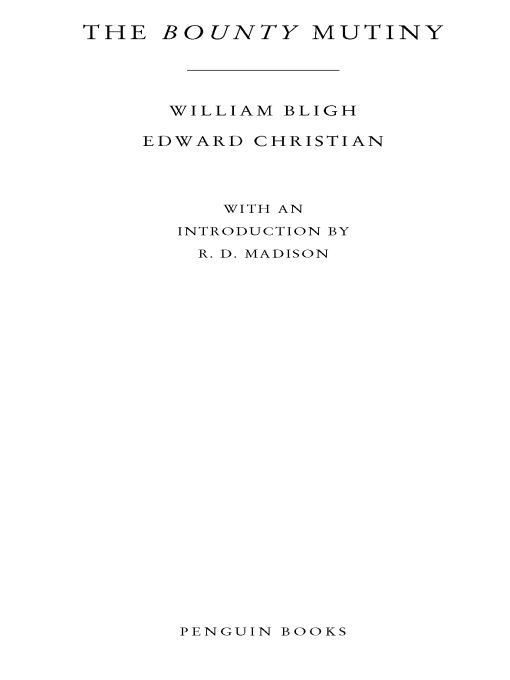
 CLASSICS
CLASSICS